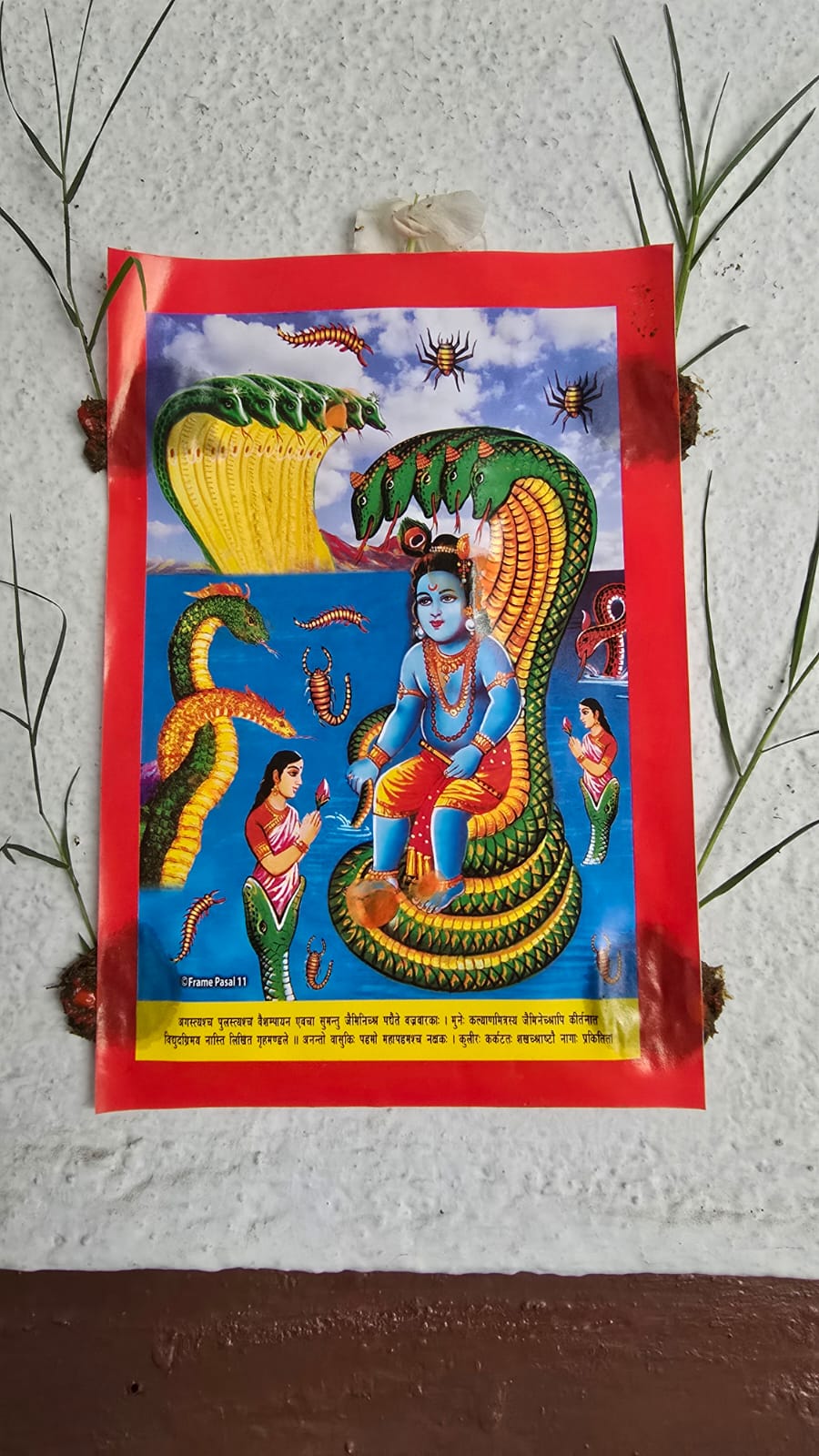Lagpachai Festival of Nāgas in Hindu Mythology, Mithila

Nag Panchami, also known as Lagpachai in Nepali, is a Hindu festival celebrated in honor of the serpent deities, Nagas. It falls on the fifth day (Panchami) of the bright half (Shukla Paksha) of the Hindu month of Shravan, which usually occurs in July or August. In 2025, Nag Panchami will be celebrated on July 29th.
During Nag Panchami, devotees worship the Nagas, seeking blessings for protection from snakebites, fire, and other misfortunes. Many people paste pictures of snakes on their doorways and offer milk and other items to the serpent deities. It's a day when women also pray for the well-being of their brothers. The festival is widely celebrated throughout Nepal and India
🐍 Major Nāgas (Individual Names)
These Nāgas are often treated as distinct types due to their mythological significance:
- Shesha Nāga (Ananta)
King of all Nāgas.
Supports Lord Vishnu as a divine couch.
Symbolizes infinity and cosmic balance.
- Vasuki
Churning rope during the Samudra Manthan.
Devotee and servant of Lord Shiva.
- Takshaka
Nāga king who bit King Parikshit.
Central to the Sarpa Satra story in the Mahabharata.
- Karkotaka
A magical Nāga who aided King Nala.
- Padma
Listed among the eight great Nāgas.
- Mahāpadma
A guardian Nāga, keeper of hidden treasures.
- Kambala
Associated with prosperity and fertility.
- Ashvatara
Mentioned in both Hindu and Buddhist lore.
- Elapatra
A wise Nāga known for spiritual discourses.
- Shankhapala
A Nāga who practiced spiritual disciplines and penance.
🐉 Ashta Nāgas (Eight Great Nāgas)
Worshipped across South Asia, especially in temples dedicated to Nāga deities:
Ananta (Shesha)
Vasuki
Takshaka
Karkotaka
Padma
Mahāpadma
Shankhapala
Kulika
These Nāgas are guardians of elemental forces, wisdom, and the treasures of the earth.
🌊 Types by Roles or Symbolism
Nāgas are categorized based on their roles and habitats:
Water Nāgas – Dwell in oceans, rivers, and lakes (e.g., Vasuki).
Underworld Nāgas – Reside in Pātāla or nether realms (e.g., Shesha).
Sky Nāgas – Rarely mentioned, linked to rain and thunder.
Divine Nāgas – Like Ananta, they maintain cosmic order.
Cursed Nāgas – Like those cursed in the Mahabharata saga.
🧬 Nāga Lineages (Clans or Gotras)
Certain Nāgas belong to identifiable lineages:
Airavata Nāgas – Possibly descendants of the elephant king.
Vasuki’s Clan
Takshaka’s Family
Kaliya Nāga's Line – Known from Krishna's legends.
These lineages are sometimes equated with different kinds of serpents with distinct traits.
🌿 Folk and Regional Nāgas
Nāga worship continues across South and Southeast Asia:
🛕 Manasa Devi
Serpent goddess worshipped in Bengal and Assam.
Symbol of fertility and protection from snakebites.
👸 Nāga Kanyas
Nāga maidens, often depicted in Buddhist and Hindu lore.
🌾 Nāga Devatas
Local serpent gods of villages and forests in India and Nepal.
They are worshipped especially during the Nāga Panchami festival.
🧘♂️ Nāgas in Spiritual Symbolism
Nāgas are also seen as:
Protectors of Dharma
Guardians of treasure (Nāga Nidhis)
Sources of hidden wisdom
In Buddhist tradition, Mucalinda Nāga protected the Buddha during meditation by covering him with his hoods.
Conclusion
The lore of Nāgas is a rich tapestry of divinity, elemental force, and moral symbolism. Whether cosmic (Shesha), divine (Ananta), or local (Manasa Devi), Nāgas continue to inspire devotion, fear, and wonder in equal measure.
"May the guardians of the earth and water bless you with wisdom and serenity."
References:
Mahabharata
Vishnu Purana
Garuda Purana
Local folklore and temple traditions
📚 How to Cite This Post
BibTeX
@article{yadav{{ page.date | date: "%Y" }}{{ page.title | slugify | replace: '-', '' }},
title = {Lagpachai Festival of Nāgas in Hindu Mythology, Mithila},
author = {Sumit Yadav},
journal = {Tatva},
year = {{{ page.date | date: "%Y" }}},
month = {{{ page.date | date: "%B" }}},
day = {{{ page.date | date: "%d" }}},
url = {https://tatva.sumityadav.com.np/posts/2025/07/29/lagpachai-maithili-festival-types-of-nagas/},
note = {Accessed: {{ site.time | date: "%B %d, %Y" }}}
}
APA Style
Yadav, S. ({{ page.date | date: "%Y, %B %d" }}). Lagpachai Festival of Nāgas in Hindu Mythology, Mithila. ." Tatva, {{ page.date | date: "%d %b %Y" }}, https://tatva.sumityadav.com.np." Tatva. {{ page.date | date: "%B %d, %Y" }}. https://tatva.sumityadav.com.np/posts/2025/07/29/lagpachai-maithili-festival-types-of-nagas/.
Note: This citation format is automatically generated. Please verify and adjust according to your institution's specific requirements.